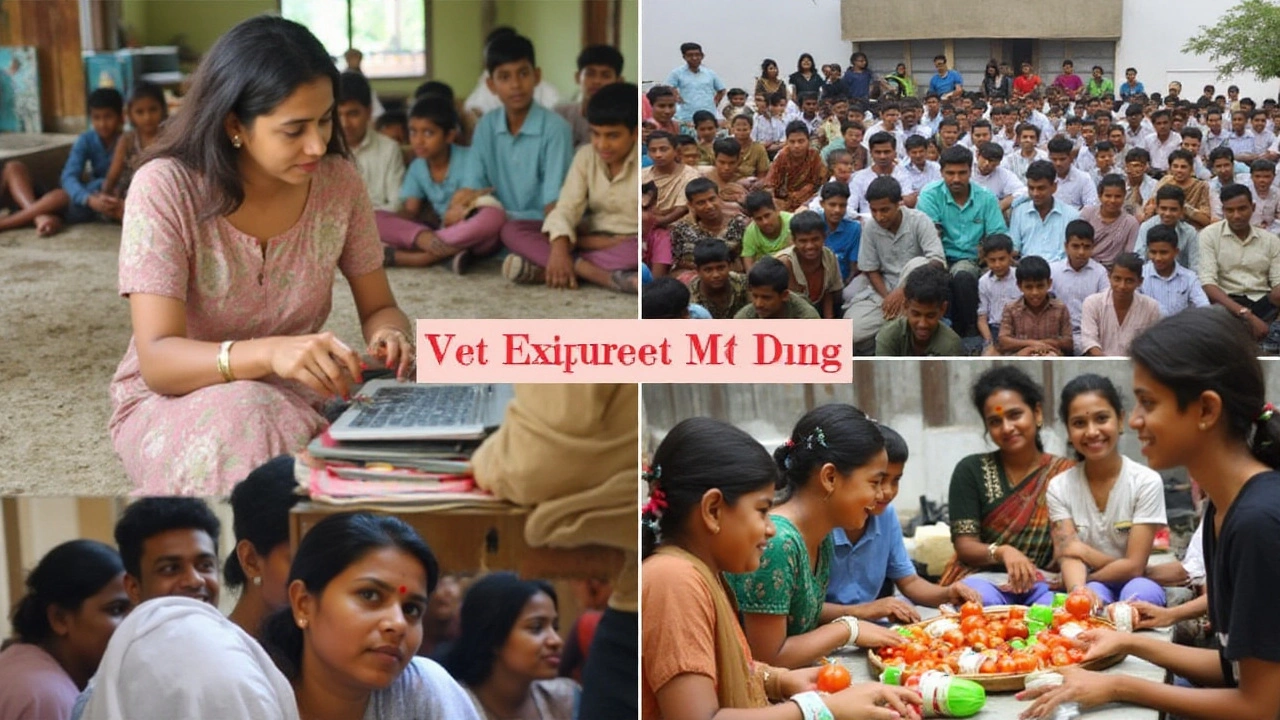Why People Hesitate to Volunteer: Unveiling the Top Reasons
 Nov, 22 2024
Nov, 22 2024
Volunteering is often regarded as a rewarding activity, providing both fulfillment and community benefits. Yet, despite its undeniable merits, many individuals hold back, finding themselves confined by various barriers that deter their involvement. Understanding these obstacles is a crucial step in promoting a culture of volunteerism and fostering community spirit.
One primary reason people hesitate is the perceived lack of time. Our modern, fast-paced lives leave little room for additional commitments. This challenge, although common, can be addressed with creative time management and setting realistic volunteering goals. Financial concerns also play a significant role, as many fear additional expenses associated with volunteering. Mitigating these concerns by choosing opportunities that fit personal budgets can make volunteering more accessible.
Often, the hesitance stems from a simple lack of information. Many potential volunteers are unsure where to begin or which opportunities align with their interests and skills. Creating awareness and providing clear pathways can significantly improve participation rates. Addressing these and other barriers in a supportive manner can ignite a volunteer movement that benefits both individuals and the communities they aim to serve.
- Understanding the Appeal of Volunteering
- Time Constraints and How to Manage Them
- Financial Considerations and Solutions
- Lack of Information or Awareness
- Finding the Right Fit for Your Interests
- Fostering a Supportive Environment
Understanding the Appeal of Volunteering
Volunteering carries a broad spectrum of appeals that transcend mere altruism. While the foundation may rest on helping others, the benefits ripple outward, influencing all facets of life and society. People are drawn to volunteer opportunities not only to make a positive impact but also to enrich their personal lives in surprising ways. Often, the personal gains are just as significant as the societal contributions. By donating their time and skills, individuals frequently report a heightened sense of purpose and increased happiness derived from their actions. According to a study published by the Corporation for National and Community Service, volunteers tend to have lower mortality rates, greater functional ability, and lower rates of depression later in life, regardless of socioeconomic status.
The allure of engaging in community service or other philanthropic activities is deeply rooted in the social connections fostered. Building lasting relationships with like-minded individuals provides a support system that extends beyond typical social settings. The camaraderie found within volunteer groups is unmatched since it stems from shared values and goals, not simply proximity. These social contexts often provide a platform for volunteers to grow networks that can lead to new personal and professional opportunities. A report from Harvard Health Publishing highlights that social connections linked to community service can improve mental health by alleviating loneliness and depression.
Beyond sociability, volunteering presents myriad opportunities for skill development. Participants can learn new abilities or hone existing ones, ranging from leadership and communication to more technical competencies. This experiential learning often happens in real-time and under circumstances that require creative problem-solving, thus offering robust preparation for real-world challenges. Many career coaches encourage professionals to consider volunteering as a way to explore potential new career paths or to accumulate experience that can enhance their resumes and job prospects. Moreover, as people delve into volunteering, they become acquainted with the profound fulfillment that comes from aligning one’s actions with their values, which in turn fosters personal growth.
In addition, there is the undeniable allure of making a visible impact, of seeing firsthand the difference one can make in the lives of others or in the improvement of community resources. The notion of contributing to something larger than oneself propels many to seek out opportunities where they can leave a tangible mark. The Rockefeller Foundation findings indicate that people who see the results of their work tend to invest more time and resources, thus amplifying their positive impact. This desire is often bolstered by the internal satisfaction of knowing one's actions contribute meaningfully to enhancing the social fabric.
"The best way to find yourself is to lose yourself in the service of others." - Mahatma Gandhi
This famous quote encapsulates the essence of volunteering, calling attention to the transformative nature of selfless service. When people engage in voluntary work, they embark on a journey of self-discovery. Through interaction with diverse communities and challenges, they gain perspectives that broaden their understanding of the world and their places within it. Each completed task or project offers an opportunity for reflection and insight, leaving volunteers enriched by the experience. This constant cycle of giving and receiving lies at the heart of what makes volunteering so appealing.
Time Constraints and How to Manage Them
The prevalent notion of a busy life is often an obstacle to embracing volunteer opportunities. People frequently cite time constraints as a major reason for not becoming involved in community service. In today's world, where every minute is accounted for, and schedules are packed tighter than a crowded train, finding time to volunteer might seem like a luxury. However, by reassessing how time is managed and understanding that volunteering doesn't require an overwhelming commitment, anyone can uncover pathways to contribute meaningfully to society. The secret lies in fitting volunteering efforts strategically rather than sacrificing essential tasks.
It's important to note that volunteering doesn't require dedicating entire weekends or large blocks of time. Micro-volunteering is a concept gaining popularity; it involves committing to short-term and often one-off projects, perfect for those with tight schedules. Small actions like helping at a local event or conducting a quick skill-sharing session can be incredibly impactful without being time-consuming. Modern technology also enables virtual volunteering, allowing people to offer their skills remotely, which can be conveniently slotted into brief breaks in an otherwise hectic day.
Creating a schedule that includes volunteering starts with prioritization. Assessing and organizing daily activities can reveal surprising pockets of free time. Allocating just an hour or two in a week towards volunteering can yield profound benefits. According to a study published by the Corporation for National and Community Service, individuals who volunteer report greater satisfaction with both their jobs and personal life. This research demonstrates that the personal and social returns on this investment of time can outweigh the initial adjustment required to incorporate volunteering into a busy lifestyle.
"The best way to find yourself is to lose yourself in the service of others." — Mahatma Gandhi
Establishing firm boundaries and realistic expectations is critical. Be honest about how much time can be genuinely committed without compromising other responsibilities. Clear communication with volunteer coordinators about one's availability ensures that the experience remains manageable and rewarding. Balancing these needs with the desire to contribute promotes a positive experience, which can foster long-term commitment to volunteerism without the stress or burnout that can occur when stretching oneself too thin.
Engaging family and friends can also transform volunteering into a social activity rather than an isolated task penciled onto one's calendar. When volunteering becomes a shared experience, it serves as a wonderful opportunity for bonding while achieving something good. This approach not only makes volunteering feel less like a chore but also adds an element of enjoyment, making it a delightful inclusion in a busy routine rather than an obligation. By seeing it through the lens of a shared venture, the burden of time is effectively distributed, making space for it amidst the bustle of everyday life.
In conclusion, when confronted with the challenge of time, the solution involves creativity, flexibility, and a willingness to integrate community service seamlessly into one's lifestyle. Such an approach ensures that volunteering doesn't overshadow daily responsibilities; instead, it enhances life's tapestry with the rich tapestry of social contribution, all while nurturing personal growth and fulfillment.

Financial Considerations and Solutions
For many, the idea of volunteering conjures images of generous acts and selfless giving, yet it simultaneously evokes concerns about money. It's not uncommon for potential volunteers to worry about the financial implications of their altruistic endeavors. Not only does this include direct costs like transportation and potential equipment, but also the indirect costs, such as time away from other commitments that might be income-generating. Financial constraints can pose a significant barrier, especially in economies where every cent counts. However, understanding and addressing these concerns can open up volunteer opportunities for a more diverse range of participants.
Interestingly, research indicates that most volunteering activities do not necessitate a hefty financial outlay. Many organizations seeking volunteers cover necessary expenses or provide resources like tools and training. Additionally, some volunteer roles can be conducted remotely, reducing travel costs significantly. This shift to virtual volunteering has been a game-changer, providing flexibility and lowering barriers for economically-conscious individuals. Considering that approximately 28% of volunteers conduct their activities online, remote opportunities offer a practical solution while also remaining integral in today’s digital-dominated era.
"Volunteering is at its essence about giving, but that doesn’t mean it should cost you," says Patricia Scott, Director of Community Engagement at a renowned nonprofit. "Organizations aware of these financial barriers are increasingly stepping in to ensure no one is deterred by out-of-pocket expenses."
For those interested in community service, budgeting for volunteering is another strategic approach. This involves integrating the potential costs of volunteering into monthly financial plans, ensuring that giving back does not interfere with essential living expenses. Setting aside a modest amount each month can create a dedicated fund for unexpected volunteering costs, allowing individuals to engage without financial stress.
Moreover, many who seek profit from volunteering can explore stipendiary roles. Some volunteer positions offer stipends or reimbursements, making it easier to balance out-of-pocket expenses. Government programs or large nonprofits sometimes provide financial support to encourage participation in critical areas lacking manpower. If interested in such options, prospective volunteers should actively seek out these positions during their initial search, aligning financial needs with their altruistic intentions.
| Type of Volunteer Role | Typical Financial Support |
|---|---|
| Remote Volunteer Work | Minimal, usually no direct cost |
| Stipendiary Positions | Offers stipends or reimbursements |
| On-Site Roles with Expenses | Possible organization-funded transportation/meals |
Ultimately, transparency about financial concerns and potential costs should be a part of the conversation from the outset. Nonprofits and volunteer organizations can play their part by openly addressing these issues and validating the economic considerations of would-be volunteers. As a result, organizations might find themselves with a broader, more economically inclusive volunteer base, fostering a more diverse coalition of community advocates devoted to making positive changes.
Lack of Information or Awareness
Despite the widespread recognition of volunteering as a positive endeavor, a surprising number of individuals find themselves unsure about where to begin their journey in community service. This uncertainty often stems from a paucity of information or a lack of awareness about available volunteer opportunities. Whether it's the bustling metropolis or a quiet rural area, each community can offer a multitude of ways to contribute, yet these are not always effectively communicated to potential volunteers.
Many organizations, while brimming with enthusiasm to welcome volunteers, sometimes fail in adequately advertising their needs. Modern digital tools like social media and community forums could bridge this gap, yet they remain underutilized in many regions. Encouraging organizations to provide vivid, accessible descriptions of roles and the impact volunteers can have—both briskly and engagingly—can remove that initial barrier between intention and action.
Youth, surprisingly, exhibit one of the highest hesitance levels due to this lack of clarity. A 2019 survey revealed that approximately 30% of young adults expressed interest in volunteering but did not know where to look for opportunities. This demonstrates a potent need for outreach programs tailored to younger demographics, perhaps through platforms they most frequently use. Here, educational institutions can play a pivotal role, with schools and universities acting as intermediaries, inclusion of volunteering modules as part of curriculum can dramatically increase participation.
It’s crucial that individuals understand not just where to volunteer but also how their participation could resonate within the community. Highlighting past success stories, sharing testimonials and experiences, can illuminate the often overlooked personal growth and networking opportunities volunteering presents. As Albert Schweitzer wisely noted,
"The only ones among you who will be really happy are those who will have sought and found how to serve."Sharing these narratives can instill inspiration and dismantle the cloak of ambiguity that clouds the volunteering landscape.
Local governments and nonprofits can spearhead initiatives that provide clear and comprehensive databases or directories of volunteer opportunities. Incentivizing engagement through these platforms could round out a successful strategy. Continual updates and real-life testimonials can enhance credibility and attract a diverse group of volunteers. Recognizing and addressing these informational disconnects are steps that could vastly increase social contribution and community engagement.

Finding the Right Fit for Your Interests
Embarking on the journey to volunteer is like seeking a new adventure—it should resonate with your passions and skills. Finding the right volunteer opportunities begins with introspection. Start by assessing what genuinely sparks your interest. Are you drawn to environmental causes, or does the idea of mentoring the youth excite you? Reflecting on past experiences can also provide clarity. Often, people overlook their hobbies as potential volunteer avenues, yet these can be richly fulfilling paths for contributing to the community.
Once interests are clear, the next step is research. Thanks to the digital age, most organizations have a presence online. Websites dedicated to community service allow potential volunteers to match their skills and passions with current needs. Consider platforms like VolunteerMatch or Idealist, which offer a broad spectrum of opportunities categorized by cause and location. They simplify the process by allowing you to filter by what matters to you most, ensuring your time spent volunteering is both impactful and enjoyable for you.
Networking is another powerful tool when navigating the volunteer landscape. Many volunteers find their loves and niches through word of mouth. Reach out to friends and family who are already involved in volunteering. Often, they can provide insights into volunteering barriers you might face and how to overcome them. It can also be beneficial to attend community events or informational sessions that introduce different facets of volunteering. You might be inspired by a cause you hadn't previously considered!
Customization of the volunteering experience can also play a pivotal role. Tailor your involvement to fit your lifestyle and current commitments. Many organizations offer virtual volunteering options, perfect for those constrained by location or time. Be open to exploring new roles within the same organization; sometimes a small shift can align volunteering duties better with your abilities and interests.
Nina Vasan, author of 'Do Good Well: Your Guide to Leadership, Action, and Social Innovation,' encapsulates this adaptability beautifully.
"Volunteering is not just about filling gaps; it's about innovating solutions. When you volunteer, consider how your unique skills can lead to new initiatives or improvements."
As enthusiasm grows, it's crucial to keep in mind that volunteering isn't solely about giving. It’s equally about personal growth and fulfilling interactions. According to recent surveys, volunteers frequently report a high sense of satisfaction and learn skills they never anticipated. This fusion of personal reward and community service ensures that your involvement doesn't feel like another task on your to-do list, but a worthwhile endeavor enriching both your life and those you help.
Fostering a Supportive Environment
Creating an environment where volunteer opportunities flourish involves more than just matching tasks with helping hands. It requires building a culture that values and celebrates social contributions, making every volunteer feel appreciated and integral to the community. This begins with organizations clearly communicating their missions and the tangible impacts volunteers make. By sharing success stories and progress updates, a sense of belonging and purpose can be instilled, encouraging continuous participation.
An effective way to foster such an environment is by offering a robust support system for volunteers. This can be achieved through comprehensive training programs that prepare individuals for the roles they undertake. People often hesitate to volunteer due to a lack of confidence in their abilities; thus, equipping them with the necessary skills boosts competence and satisfaction. Additionally, mentorship opportunities where seasoned volunteers guide newcomers can bridge the gap, ensuring smooth transitions and fostering a sense of community.
Organizations can also focus on creating a feedback loop, allowing volunteers to voice their thoughts and suggestions. This open communication enhances the experience, making volunteers feel valued. Recognizing and appreciating volunteers through awards or simple thank-you notes can significantly impact their motivation and dedication. As the saying by Marsha Evans goes, "Volunteers do not necessarily have the time; they just have the heart," highlighting the passion driven by a supportive environment.
One of the lesser-discussed yet crucial aspects is providing flexibility. Many people cite time constraints as a barrier; thus, organizations offering flexible hours or remote opportunities can broaden their volunteer base. By accommodating different schedules, even those with limited availability can contribute, increasing overall engagement. Moreover, encouraging diversity and inclusivity within volunteer groups enriches the experience for everyone involved, bringing varied perspectives and broader skill sets to the table.
To provide tangible acknowledgement, a review of the current volunteer landscape reveals interesting statistics.
| Aspect | Percentage |
|---|---|
| Volunteers who value appreciation | 85% |
| Supportive environments' impact on retention | 78% |
Ultimately, fostering an environment where volunteering is encouraged and supported leads to a thriving community. By centering the experience around the volunteer, organizations can build lasting relationships, creating a cycle of community empowerment and growth. Not only does this approach benefit the causes at hand, but it also cultivates the personal growth and fulfillment of each volunteer, ensuring that the spirit of giving remains strong and impactful.